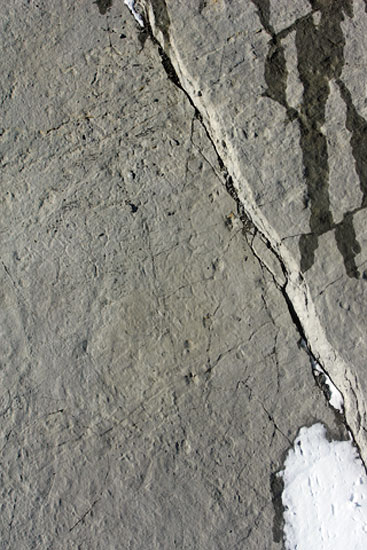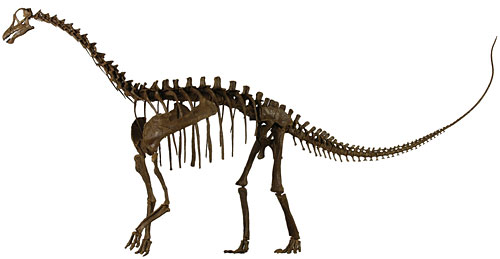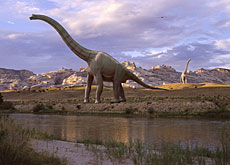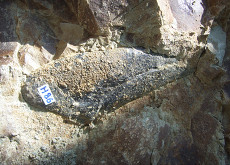Hunting early predators in the Alps

Giant dinosaur footprints have been found in a rock face in Switzerland's eastern Alps – bigger than any other known tracks from such an early period.
Experts from the Basel Natural History Museum say the footprints measure 40cm and were left by predatory dinosaurs on what was the bed of a shallow sea during the Triassic period.
“Obviously this dinosaur did not wear crampons 205 to 210 million years ago, otherwise we would see it clearly,” joked Christian A. Meyer, a palaeontologist from Basel.
The footprints cross a vertical rock face of the Piz Ela mountain in central Graubünden. But about 250 to 200 million years ago the cliff was part of a flat seafloor which some 140 to 150 million years later – through what is known as the influence of plate tectonics – became Europe’s highest mountain belt, the Alps.
Dinosaurs are believed to have trodden much of the prehistoric supercontinent, but the reason why the footprints at Piz Ela survived over time while others disappeared is because they were left on lime sludge which amalgamated with blue-green algae and bacteria.
“This substance was similar to cotton wool, compact and tough,” said Meyer.
Then over millions of years the mud slowly turned into stone.
“Layers and layers of mud piled up. Pressure increased and temperatures changed. This is how what used to be a beach turned into solid rock.”
Tall predators
Experts hope the footprints in the Ela Nature Park will tell them more about the giant creatures.
“We will examine the finds over the next few weeks. This will allow us to say how tall this animal was and how fast it could walk. We can do this because we have several sequences of footprints,” said Meyer.
Furthermore, it is not difficult to deduce the height of the hip “if you know the size of the shoe”, he added.
There are certain known proportions for mammals as well as for reptiles. Based on the size of the step it is possible to calculate the speed of a walking animal, according to experts. Huge predatory dinosaurs were between 4.5 and seven metres tall.
Discovering a dinosaur track takes a lot of experience and depends on a certain light. Meyer says it is only possible to recognize the prints in the shade: they are invisible when the light is shining straight onto them.
The traces in Graubünden are the biggest footprints discovered to date.
“It was not known that predatory dinosaurs this size lived during that period. Normally prints from this period are only up to 20cm,” said Meyer.
So far only one skeleton has been found in northern Germany, and it is slightly later.
Footprints of other prehistoric reptiles were also discovered, notably plant eating dinosaurs and medium-sized predatory dinosaurs.
Earlier but not accessible
Meyer says the traces will allow scientists to study the period in more detail.
“The tracks allow us to show that giant predatory dinosaurs obviously developed earlier during evolution than previously thought,” he pointed out.
Up until now the only known footprints measuring 40cm dated from the Early Jurassic, a later period from 199.6 to 175.6 million years ago.
The newly-discovered footprints at Piz Ela will remain out of reach to the public. It takes an eight-hour hike to even get near. But there is something to look forward too for enthusiasts.
“We will make a cast of the prints over the next two years,” said Meyer.
They will be on show for visitors at the Ela Nature Park or at a museum in Chur.
Models of the predators which left their footprints at Piz Ela may also be made if enough funds can be raised for the project.
Eveline Kobler, swissinfo.ch (adapted from German by Urs Geiser)
The Alps arose as a result of the collision of the African and European tectonic plates.
Their formation began about 135 million years ago and ended about 30 to 35 million years ago.
Parts of the Pangaea supercontinent broke off and the African plate was pushed against the European landmass.
Due to this pressure the sedimentary layers of the former sea were piled upon each other creating the belt of mountain chains, known as the Alps.
Most dinosaur footprints were found in the Jura mountains in northwestern Switzerland on a surface of 4,000m2.
They will be accessible for the first time for the public during the weekends of August 22/3 and August 29/30.

In compliance with the JTI standards
More: SWI swissinfo.ch certified by the Journalism Trust Initiative













You can find an overview of ongoing debates with our journalists here . Please join us!
If you want to start a conversation about a topic raised in this article or want to report factual errors, email us at english@swissinfo.ch.